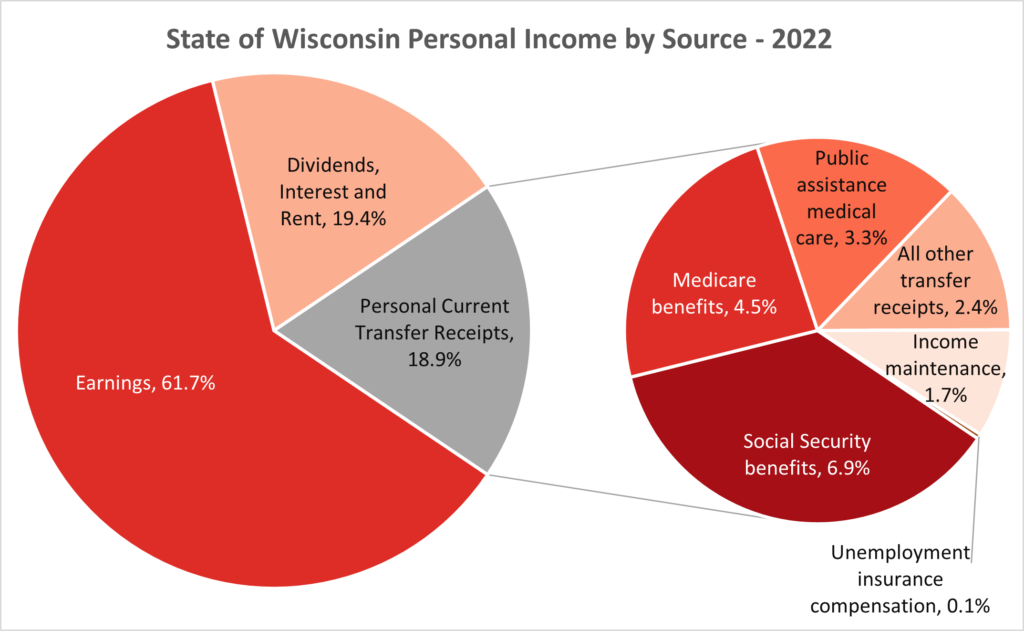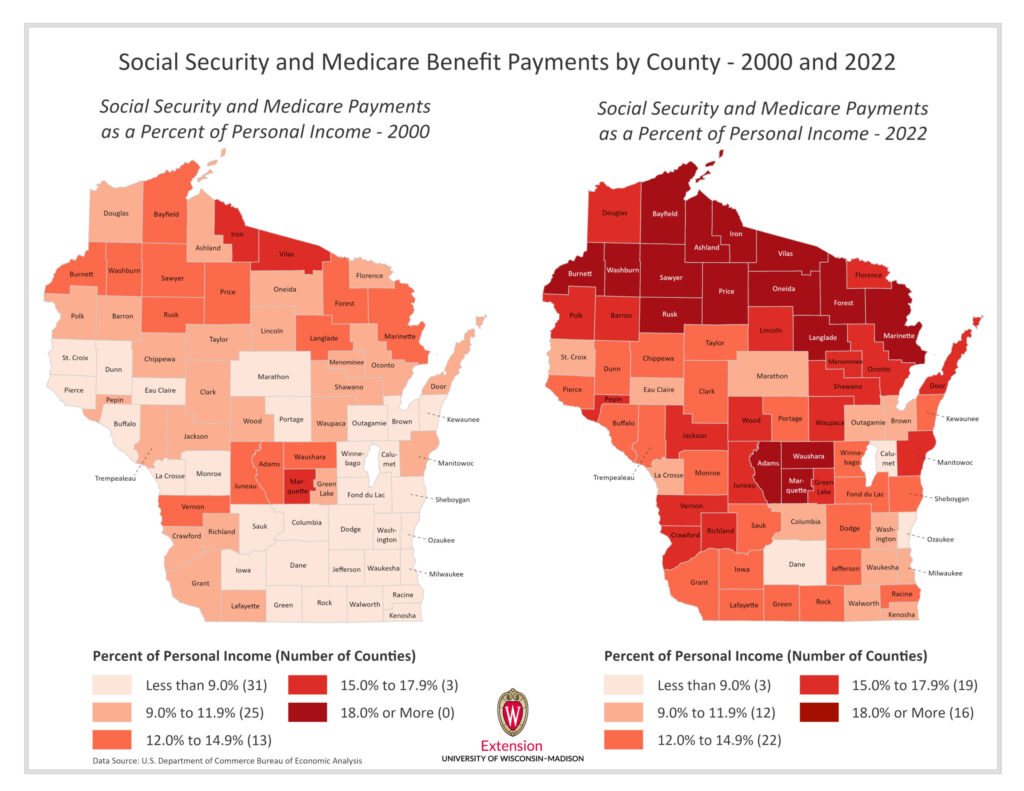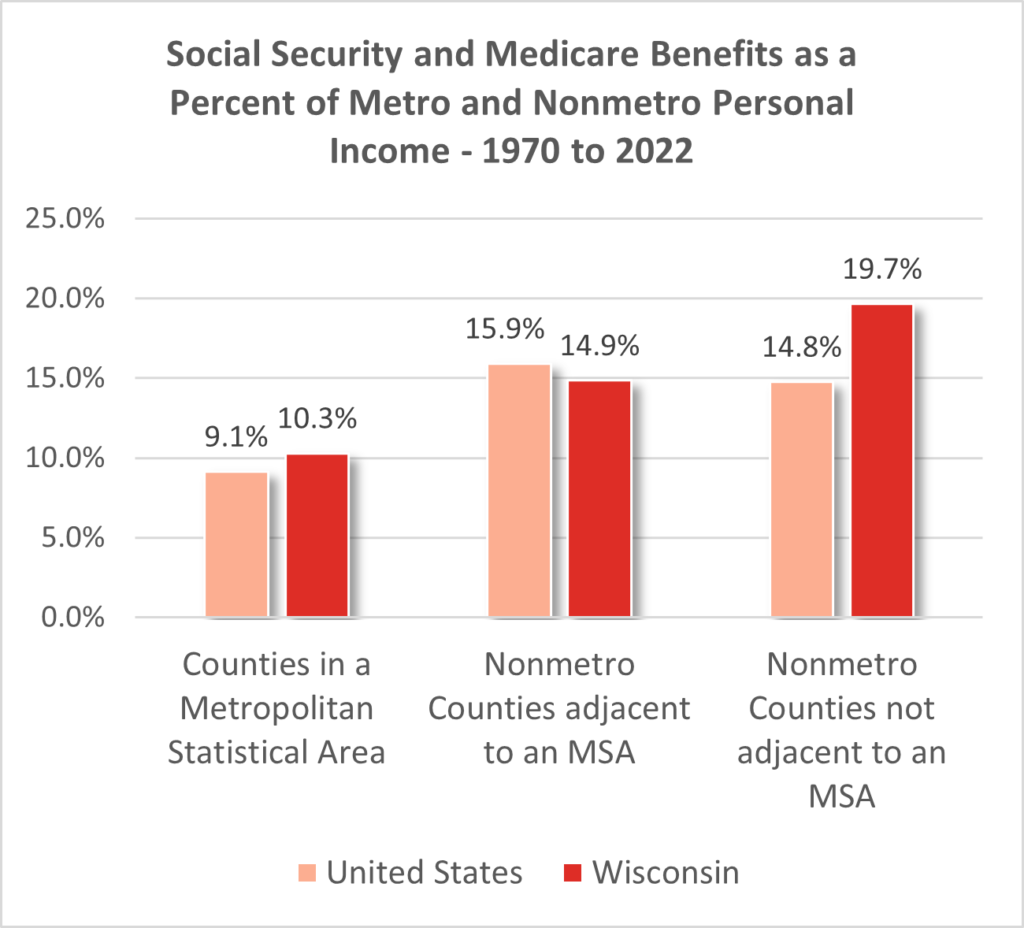(Image Source: Markus Winkler / Unsplash)
Wisconsin IDEA
Insight • Data • Economics • Analysis
Wisconsin has an Increased Reliance on Social Security and Medicare Amidst Aging Demographics
Local area personal income is the total income in an area received by individuals from three primary sources: 1) earnings; 2) dividends, interest and rent; and 3) personal current transfer receipts. Income from earnings includes payments in the forms of wages and salaries, certain employer-paid benefits, and proprietor’s income. Personal income in the form of dividends, interest and rent is income obtained through investments, interest-bearing accounts, and income gained through the rental of property, copyrights, patents, and natural resource rights. Personal transfer receipts include payments from a variety of government social benefit programs such as retirement (e.g. Social Security), disability payments, medical benefits (e.g. Medicare and Medicaid), income maintenance payments (e.g. Supplemental Security Income, Earned Income Tax Credits, and Supplemental Nutrition Assistance Program payments), unemployment insurance, veterans benefits and education assistance.
Figure 1. State of Wisconsin Personal Income by Source, 2022

An area’s share of income from different sources is influenced by a variety of factors. For instance, income from earnings is typically an area’s largest source of income, but the share of income from earnings can be influenced by economic cycles and local economic conditions. Accordingly, the share of income from earnings may decline during economic downturns with a corresponding increase in the share of income from certain personal transfer payments such as unemployment insurance. In 2022, 61.7% of Wisconsin’s personal income was derived from earnings; 19.4% was gained from dividends, interest and rent; and the remaining 18.9% was attributed to personal current transfer receipts. Social Security benefits were the largest source of transfer receipts (6.9% of personal income), followed by Medicare (4.5%), and public assistance medical care (3.3%). The remaining shares of transfer receipts include income maintenance payments, unemployment insurance and a combination of several smaller categories.
Figure 2. Social Security and Medicare Benefits as a Percent of Local Area Personal Income, 1970-2022

An area’s reliance on various income sources can also be impacted by other factors including its demographic composition. As an example, consider the share of income from derived from Social Security and Medicare benefits; Wisconsin’s two largest sources of personal transfer receipts in 2022. As Social Security and Medicare payments are primarily received by people who have reached a qualifying age (e.g. at least age 62 for social security and age 65 for Medicare), it is not surprising that Wisconsin’s share of total personal income from Social Security and Medicare has increased from 5.2% in 1970 to 11.4% in 2022 as the state’s population has aged.
Map 1. Social Security and Medicare Benefit Payments by County, 2000 and 2022

Figure 3. Social Security and Medicare Benefits as a Percent of Metro and Nonmetro Personal Income, 1970-2022

While dependence on Social Security and Medicare payments varies among Wisconsin’s counties, every county had greater share of income from these two sources in 2022 than in 2000. Furthermore, the number of Wisconsin counties with 15% or more of total personal income attributed to Social Security and Medicare benefit payments increased from three in 2000 to 35 in 2022. The biggest increases were found in Burnett County, Sawyer County, and Adams County, which is not unexpected given that these counties have experienced notable rates of net in-migration among retirement-aged individuals over the last several decades.
Map 2. Social Security and Medicare Benefits Payments, 2022

From a national perspective, several Wisconsin counties are in the highest quintile (i.e. top 20%) of counties with the highest shares of income derived from Social Security and Medicare. Other areas with notably high shares include many counties throughout the Appalachian Region, portions of many Sun Belt states, and regions of Missouri, Arkansas, Kansas, Michigan and Minnesota. When considering the share of income from Social Security and Medicare benefits across the rural-urban continuum, we see that nonmetro counties on average are disproportionately dependent on Social Security and Medicare payments compared to counties in a metropolitan statistical area. As many areas in Wisconsin and the United States, both metro and nonmetro, are projected to have a growing share of residents over the age of 65, their dependence on Social Security and Medicare could increase as well.















